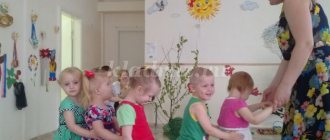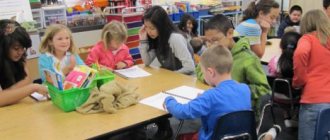Self-analysis of the lessonmaterial in mathematics (middle group) on the topic
Self-analysis of FEMP classes in the middle group
on the topic: “Inhabitants of the Land of Fairy Tales”
Goal: formation of completed elementary mathematical concepts in children of the middle group.
Training tasks:
- Fix ordinal and quantitative counting within 5.
- Improve your knowledge of geometric shapes. Strengthen your knowledge of color.
- Improve the ability to compare objects by height, arrange them in ascending and descending order, and indicate the results of comparison with the words: highest, lowest, lowest.
- Expand your understanding of the parts of the day and their sequence: morning, afternoon, evening, night.
- Improve the ability to equalize unequal groups in two ways.
Educational:
Develop attention, logical thinking, fine motor skills, visual perception and memory.
Educational:
Cultivate interest in mathematics, the ability to act together, and bring the job started to completion.
Direct educational activities were carried out with children of the middle group, age from 4 to 5 years. There are 12 children. Duration 20 minutes.
When developing this outline of educational activities, I primarily took into account: the age, mental and individual characteristics of children in the middle group. Taking all this into account, I determined: the goal, objectives, content, form of educational activities, methods, techniques and means necessary for positive results.
The lesson consisted of three parts, during which the children performed various actions step by step. This structure is completely justified, since each part of the GCD is aimed at solving certain problems and offers a choice of methods and techniques.
Introductory part: organizing children, motivation for upcoming activities. The organizational technique “Greeting” in poetic form was aimed at developing communicative qualities and establishing friendly relationships between me and the children. The children were invited to go to the Land of Fairy Tales and complete tasks.
The main part of the educational activity was a specially organized and independent activity of children aimed at solving assigned problems. The lesson was carried out in accordance with the notes. At every moment of the lesson there were visual aids that stimulated and activated the children’s mental activity. The lesson is dynamic, moving around the group during the lesson allowed the children to avoid fatigue.
In the final part, I consolidated the positive results of the lesson with verbal encouragement.
All aspects of the lesson are logical and consistent, subordinated to one topic. The lesson integrated points from educational areas:
• Cognitive development: consolidated geometric shapes; counting within 5, ordinal counting; dimensional relationships between three objects of different heights; an idea of the parts of the day, their characteristic features, sequence; idea of equality and inequality of groups based on counting.
• Speech development: children participated in the general conversation and conducted a dialogue. She activated the children's vocabulary using words for the names of geometric shapes, practiced counting, and solved riddles.
• Social and communicative development: children expressed goodwill, empathy, and mutual assistance.
• Physical development: developed motor imagination and coordination of movements through physical education.
I used the following methods in my work: visual, verbal, playful, practical.
At every moment of the lesson, I tried to guide the children to find solutions to problems, helped to activate independence, maintained a positive emotional mood, and intensified the children’s mental and speech activity. During the lesson, I tried to communicate with the children on the same level, tried to maintain the children’s interest in the lesson throughout the entire time.
Analyzing the children’s activities, I would like to note that they showed cognitive activity, reacted emotionally, and used existing knowledge and skills. They were interested, attentive, organized. Encouraged indecisive and shy children to speak out.
Due to the fact that there were many choral responses, special attention should be paid to individual responses. It is also necessary to achieve clear pronunciation of words. Work on sound pronunciation, expand active and passive vocabulary.
But despite this, I believe that all the program tasks I set during the lesson were solved.
Self-analysis of direct educational activities on FEMP in the preparatory group
Elena Mambetova
Self-analysis of direct educational activities on FEMP in the preparatory group
Self-analysis of educational activities directly
on the formation of elementary mathematical concepts
in the preparatory group
Goal: developing interest in the subject of mathematics, based on cognitive activity and curiosity.
Tasks:
Educational . To promote the development of the ability to apply mathematical knowledge in non-standard practical problems.
Developmental. Develop mental operations: analogy, systematization, generalization, observation, planning.
Educational. Help maintain interest in mathematics and develop the ability to work in a team.
Integration of areas: socialization, communication, health, music, reading fiction.
Preliminary work:
Guessing riddles, solving logical problems, solving simple arithmetic problems, observing the calendar, individual lessons Learning physics. a minute, board games
Organization of direct educational activities (EDA)
Educational activities were carried out in the preparatory group and lasted 30 minutes.
All sanitary and hygienic requirements were met: furniture was selected To create interest, the children went on a rocket trip to the planet Mathematics, where they completed various mathematical tasks. Directly educational activities were built in a single game plot.
Changing types of activities (game, communicative, motor)
contributed to maintaining the attention and performance of children throughout their educational activities
. Physical education was used during the activity
, visual and finger gymnastics.
Structure of direct educational activities (DEA)
In its structure, the educational activity itself is designed in such a way as to arouse and maintain interest in the subject of mathematics, based on cognitive activity and curiosity.
The first part included an organizational point: preparing for the trip . to stimulate auditory attention and perception, motivation.
The second part consisted of unique stages - completing tasks: guessing riddles, “What is extra and why?”
“Name the intended number” “Remember and do”
is an exercise for the development of auditory perception, which helped maintain the attention and performance of children throughout their
educational activities .
The third part is the result, reflection.
Teaching methods and techniques
Methods and principles are selected in accordance with educational , developmental and educational objectives.
In the course of direct educational activities, visual, verbal and practical, game methods were used, aimed at the use of cognitive, speech, motor, practical skills and abilities, and their improvement.
The proposed games were selected according to the age of the children, which contributed to the solution of the assigned tasks.
Throughout the entire activity , cognitive interest was maintained using surprise moments and games.
In the process of educational activities, educational goals were also pursued: to cultivate interest in mathematics, to develop the ability to work in a team.
Various ways of including children in the educational process : intonation of speech, emotional expressiveness.
In the process of direct educational activities, work was continuously carried out to expand and enrich the vocabulary of children.
GCD effectiveness
I believe that the set goal and objectives have been achieved.
Romanova Vitalina Anatolyevna, teacher,MBDOU DS No. 10 "Lazorik" of the city of Donetsk, Rostov region
Category "Work Experience"
Self-analysis of the lesson on FEMP “Journey through Mathematics”
Self-analysis of the lesson on FEMP “Journey through Mathematics”.
We have brought to your attention a lesson on the formation of elementary mathematical concepts in children of the preparatory group.
In my lesson, I set myself the following educational goals:
— Exercise children in forward, backward, ordinal counting.
— The composition of a number from two smaller ones, previous and subsequent numbers, which number is greater, less.
- Ability to make a sum from two smaller ones.
— Measuring length with a ruler.
— Solving a problem using numbers and signs with “-” and “+”.
— Develop logical thinking.
— Cultivate a desire to show acquired knowledge and interest in the lesson.
The children were told the topic of the lesson. The structure of the lesson corresponded to the assigned tasks. It is built in a logical sequence and interconnection of the parts of the lesson. The pace of the lesson is optimal. Speech rate is moderate. The material was presented emotionally. I selected the necessary visual aids and handouts.
When planning an open lesson, the age characteristics of the children were taken into account. The material is selected at a level accessible to children. Taking into account their age characteristics, the children answered the teacher’s questions, maintained a conversation, watched with interest, examined them, and willingly took on tasks. The children were quite active, felt comfortable, and willingly took part in the lesson.
All elements of an open lesson are united by a common theme. The content of the lesson corresponded to the goals set.
During the open lesson, the following working methods were used: verbal (questions, clarification, reminder, encouragement); visual demonstration (pictures and illustrations); game.
The main part of the lesson is aimed at the development of cognitive activity, the formation of mental and practical actions. Having set specific tasks for the children, she sought from each child (depending on his capabilities) their implementation, monitored the completion of tasks, made adjustments to their knowledge, provided the necessary assistance, and encouraged even minimal success. The volume of educational material ensured the children's activity and pace of work during the lesson. Its content corresponded to the purpose of the lesson, was scientific and at the same time accessible to children. To relieve general fatigue, a ball game was played.
The final part summarized the lesson.
I believe that the form of organizing classes for children that I chose was quite effective. I tried to comply with the norms of pedagogical ethics and tactics. I believe that the objectives set during the lesson were completed.



